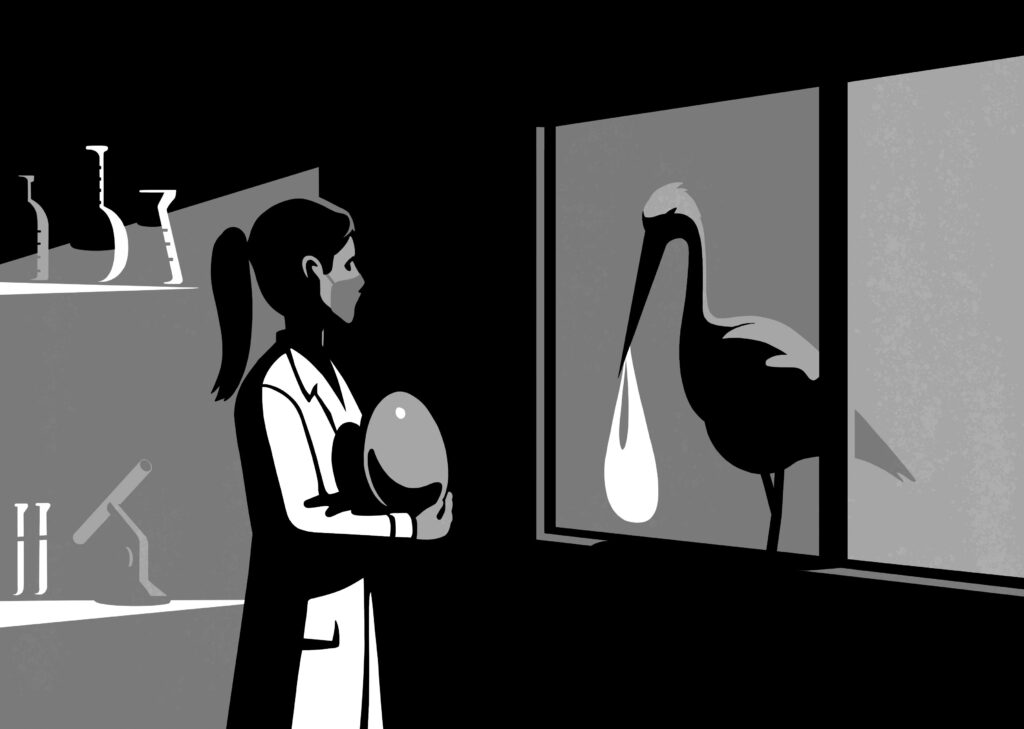That you are reading this right now means at least one thing is certain: someone, somewhere, at some point, gave birth to you. It’s as simple as that — a universal fact. “After all,” writes Claire Horn, a post-doctoral fellow at Dalhousie University, “gestation is one of the few experiences that can be said to impact everyone.” But that might not be the case for much longer.
Around the turn of the nineteenth century, the French physician Stéphane Tarnier introduced modern incubators: “glass-fronted boxes” that were heralded as a kind of “Artificial Foster-Mother.” Modelled after the warming contraption zookeepers used to help chicks grow, the “ ‘brooding-hen’ incubator” became a fixture not only in hospitals but also in fairgrounds worldwide. In 1896, spectators flocked to the Kinderbrutenstalt (child hatchery) at the Great Industrial Exposition in Berlin to catch a glimpse of the “structure for infants,” and a year later those in Britain walked away from a similar display, the Victorian Era Exhibition at Earls Court, singing a popular tune about “breeding a nation ‘by means of incubation.’ ” People were enchanted, awestruck by the possibility that babies “might soon be grown outside of the human body.” They may have been a bit too bullish. Only now have we “arrived at the brink of this peculiar dream becoming plausible.”
As of 2022, scientists in Australia and Japan had completed two animal trials for their Ex‑vivo Uterine Environment Therapy, a technology “with the intention to treat human babies born as early as twenty-one weeks.” With this innovation, in addition to developments in embryology, the world is nearing a point where “babies might be gestated, from conception to birth, without ever being carried in a person’s uterus.” In Eve: The Disobedient Future of Birth, Horn explores what artificial wombs may mean for humanity. No longer should we ask, “Is this innovation possible? The question is: Are we ready?”

Will we soon be pressing the stork back into service?
M.G.C.
“Technologies can only be as progressive as the contexts into which they are introduced,” Horn writes. She’s not optimistic. Given the overturning of Roe v. Wade in the United States in 2022 and the alleged forced sterilizations of Indigenous women across Canada, most recently in 2019, Horn believes that artificial wombs would likely bolster oppressive gender norms, advance eugenicist agendas, and further restrict reproductive rights.
In 2016, researchers at Cambridge and Rockefeller Universities successfully grew embryos in a petri dish, stopping just shy of the legal limit of fourteen days. Since then, pundits have lauded ectogenesis as the solution to the “fraught battle over abortion.” They claim that it would satisfy pro-choice and pro-life advocates because fetuses could be removed from a pregnant person’s body and still live. But the feminist legal scholar Sarah Langford has described that approach as, according to Horn, “incredibly dehumanising for the way it frames pregnant people as ‘foetal incubators.’ ” Horn agrees, stating the argument ignores “the pregnant person’s desires, needs and interests.” Forcing the removal of a fetus “into ectogenesis, rather than terminating it, would be a substantial bodily violation.” She tactfully navigates the polarized debate and calls for the worldwide right to choose. Only once abortion is treated as vital health care and access is protected will ectogenesis no longer pose a threat to reproductive rights.
She considers Canada an exemplary country for abortion law: the medical procedure is legal throughout the term, and the government prioritizes the parent’s life over the interests of the fetus. Even still, more can be done. People in rural communities often travel significant distances and incur expenses to access care, and cultural competency is lacking. On their own, legal rights are not enough. They need to be accompanied by resources.
Pregnancy can be a moving, joyful, and affirming journey. But it can also create barriers and hardships, forcing individuals to choose between starting a family and their jobs or their own well-being. In a feminist utopia, ectogenesis would have the potential to liberate women, “to make the work of care more communal, to undo the association of motherhood with women only.” Horn describes her vision:
Partial artificial wombs would be accessible to all pregnant people, to be freely chosen as a means of saving their lives and health and those of their prematurely born babies. And in the further future, ectogenesis would be a tool that people could use to build families of their choosing, regardless of their gender. It would be a means of realising kinship through love and intent, above genetics and designated sex.
It was not her intention, but Horn wrote this book while pregnant. Doing so forced her to exist in “a peculiar space between expert and novice, between intellectualising and experiencing,” which lends her work an empathetic, sensitive touch beyond the philosophical debate. “When you carry a pregnancy, you also carry the weight of legal and medical regulations and recommendations,” she writes. “You carry the burden of blame when something goes wrong.” She wonders if taking on “all the frustrations, expectations and dangers that can come with pregnancy” is too big a task for technology to manage.
Leighton Schreyer is a writer, poet, and activist.

